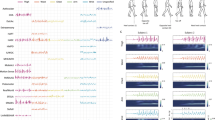Abstract
This paper explores the potential for use of an unaugmented commodity technology—the mobile phone—as a health promotion tool. We describe a prototype application that tracks the daily exercise activities of people, using an Artificial Neural Network (ANN) to analyse GSM cell signal strength and visibility to estimate a user’s movement. In a short-term study of the prototype that shared activity information amongst groups of friends, we found that awareness encouraged reflection on, and increased motivation for, daily activity. The study raised concerns regarding the reliability of ANN-facilitated activity detection in the ‘real world’. We describe some of the details of the pilot study and introduce a promising new approach to activity detection that has been developed in response to some of the issues raised by the pilot study, involving Hidden Markov Models (HMM), task modelling and unsupervised calibration. We conclude with our intended plans to develop the system further in order to carry out a longer-term clinical trial.
Similar content being viewed by others
References
Adams J, White M (2005) Why don’t stage-based activity promotion interventions work? Health Educ Res 20(No. 2):237–243
Anderson I, Muller H (2006) Context awareness via GSM signal strength fluctuation. In: The 4th international conference on pervasive computing, late breaking results. Oesterreichische Computer Gesellschaft, pp 27–31 May
Baum LE, Peterie T, Souled G, Weiss N (1970) A maximization technique occurring in the statistical analysis of probabilistic functions of Markov chains. Ann Math Stat 41(1):164–171
Bell M, et al. (2006) Interweaving mobile games with everyday life. Proc ACM CHI, pp 417–426 (Also available at http://www.dcs.gla.ac.uk/~matthew/papers/CHIYoshiWithCopyright.pdf)
Consolvo S, Everitt K, Smith I, Landay JA (2006) Design requirements for technologies that encourage physical activity. Proc ACM CHI: pp 457–466
Department of Health (2004) At least five a week: evidence on the impact of physical activity and its relationship to health. DoH, London
Duncan SC, Duncan TE, Strycker LA, Chaumeton NR (2004) A multilevel approach to youth physical activity research. Exerc Sport Sci Rev 32(No.3):95–99
Ipsos Mori, e-MORI Technology Tracker, December 2002 http://www.mori.com/technology/techtracker.shtml [last accessed 29th June 2006]
King AC, Friedman R, Marcus B, Castro C, Forsyth L, Napolitano M, Pinto B (2002) Harnessing motivational forces in the promotion of physical activity: the Community Health Advice by Telephone (CHAT) Project. Health Educ Res 17(No. 5):627–636
Korp P (2006) Health on the internet: implications for health promotion. Health Educ Res 21(No. 1):78–86
Lester J, Choudhury T, Borriello G, Consolvo S, Landay J, Everitt K, Smith, I. Sensing and modeling activities to support physical fitness. Workshop paper in UbiComp ’05 Workshop: Monitoring, Measuring and Motivating Exercise: Ubiquitous Computing to Support Physical Fitness. Tokyo, Japan, 2005
Licoppe C, Inada Y (2006) Emergent uses of a Multiplayer Location—Aware Mobile Game: the Interactional Consequences of Mediated Encounters. Mobilities 1(No. 1)
McLean N, Griffin S, Toney K, Hardeman W (2003) Family involvement in weight control, weight maintenance and weight-loss interventions: a systematic review of randomised trials. Int J Obes 27:987–1005
Mullen E, Markland D (1997) Variations in self-determination across the stages of change for exercise in adults. Motiv Emot 21(No. 4):349–362
Pate RR, Pratt M, Blair SN, Haskell WL, Macera CA, Bouchard C (1995) Physical activity and public health: a recommendation from the Centers for Disease Control and Prevention and the American College of Sports Medicine. J Am Med Assoc 273:402–407
Rabiner LR (1990) A tutorial on hidden Markov models and selected applications in speech recognition. In Readings in speech recognition. Morgan Kaufmann, San Francisco, CA, USA, pp 267–296
Siewiorek DP, Smailagic A, Furukawa J, Krause A, Moraveji N, Reiger K, Shaffer J, Wong FL (2003) SenSay: A Context-Aware Mobile Phone. In Proceedings of 7th International Symposium on Wearable Computers, ISWC. IEEE Computer Society, pp 248–249
Sparling PB, Owen N, Lambert EV, Haskell WL (2000) Promoting physical activity: the new imperative for public health. Health Educ Res 15(No. 3):367–376
Speck BJ, Harrell JS (2003) Maintaining regular physical activity in women—evidence to date. J Cardiovasc Nurs 18(No. 4):282–291
Tudor-Locke C (2002) Taking Steps Toward Increased Physical Activity: Using Pedometers to Measure and Motivate. President’s Council on Physical Fitness and Sports, June
Vandelanotte C, De Bourdeaudhuij I (2003) Acceptability and feasibility of a computer-tailored physical activity intervention using stages of change: project FAITH. Health Educ Res 18(No. 3):304–317
World Health Organisation: Move for Health http://www.who.int/moveforhealth/en/ [last accessed 29th June 2006]
Viterbi AJ (1967) Error bounds for convolutional codes and an asymptotically optimum decoding algorithm. IEEE Trans Inf Theory 13(2):260–269
Author information
Authors and Affiliations
Corresponding author
Rights and permissions
About this article
Cite this article
Anderson, I., Maitland, J., Sherwood, S. et al. Shakra: Tracking and Sharing Daily Activity Levels with Unaugmented Mobile Phones. Mobile Netw Appl 12, 185–199 (2007). https://doi.org/10.1007/s11036-007-0011-7
Published:
Issue Date:
DOI: https://doi.org/10.1007/s11036-007-0011-7




